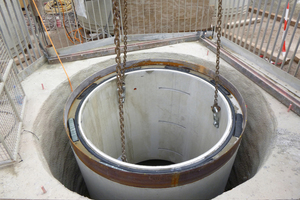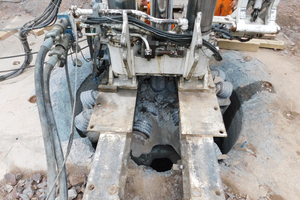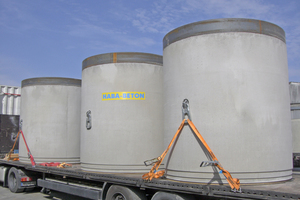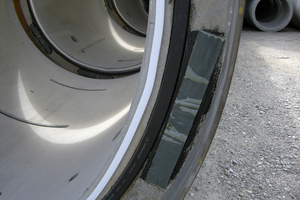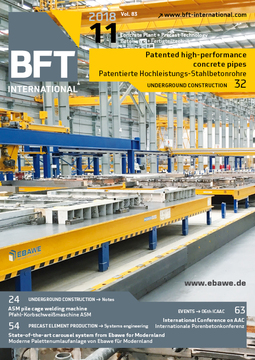Jacking pipes with special joint as shaft pipes
From Nuremberg to Erfurt in 80 minutes, from Munich to Berlin in just under four hours: the new double-track VDE 8.1 railway section designed for maximum speeds of 300 km/h has been connecting people and markets in new ways since December 10, 2017, bringing cities and regions closer together. The railway line for passenger and freight traffic is an important building block in the German Unity No. 8 (VDE 8) transport project. The €10 billion project was approved by the Federal Government in 1991 to improve transport connections both between East and West and between North and South. The first section of the line went into service in 2003.
The entire new Erfurt-Leipzig/Halle line (VDE 8.2) has been open since December 2015. After putting VDE 8.1 into service, all new sections between Nuremberg and Berlin have been completed. The new Ebensfeld - Erfurt line (VDE 8.1) is part of this project. It has a length of 107 km, and almost half of the route runs on bridges or in tunnels. As many as 22 tunnels with a total length of 41 km have been created. All tunnels exceeding 1,000 meters in length will be equipped with drivable and walkable emergency exit tunnels and shafts. In two of the shafts, reinforced concrete jacking pipes with a special joint were used as shaft pipes in FBS quality which had to meet exceptionally high requirements regarding the tightness of the joint connections.
Bleßberg Tunnel and Silberberg Tunnel
The two longest tunnels of the new Ebensfeld - Erfurt railway line are the Bleßberg Tunnel at 8,314 m and the Silberberg Tunnel at 7,391 m. Both tunnels have emergency exits which can be reached via a system of walkable or drivable rescue tunnels. Each of these tunnels is supplied with fresh air via a separate vertical ventilation shaft which has a clear inner diameter of 2 m – at an outer diameter of about 2.80 m. Each end of the shaft is connected to the drivable emergency exit tunnel via a separate ventilation tunnel.
The two shafts (52 m high in the Bleßberg Tunnel and 112 m high in the Silberberg Tunnel) were created using the raise-boring method. In the process, a circular shaft was bored from bottom to top along a pilot bore, and was subsequently strengthened with shotcrete prior to completing the shaft using water pressure-tight precast shaft rings. The annular chamber between the shaft ring and shotcrete strengthening was infilled with concrete section by section. Reinforced concrete jacking pipes with a steel sleeve and a special joint with lining segment seal were used as shaft pipes – the pipes had an effective length of 2.50 m and weighed 8.7 t. The shaft pipes from Haba-Beton were carried and moved by means of internal spherical head anchors.
Dipl.-Ing. Stefan Niedermeier from HABA’s plant based in the Bavarian municipality of Teising explains the specific hallmarks: “A suspended cage for crane use is required for transporting persons during the installation of the shaft pipes. To fix it in place, we have fitted the pipes with additional universal climbing cones embedded in the concrete. In addition, anchor channels bent radially at the factory were embedded in the concrete to enable the later attachment of shaft fixtures.”
High requirements on pipe tightness
“In order to guarantee the specified tightness, the special joint was designed with a lining segment joint adapted to the production method of pipes,” explains Niedermeier. A sealing frame made by Dätwyler was used as sealing element at the spigot and glued in a groove on both the socket end and spigot end of the pipe. Sealing tapes and joint tapes from Kaubit are serving as load compensation and as additional sealing elements. In conjunction with the steel sleeve, the external wedge-shaped sliding seal improves reliability in terms of tightness and ensures the precise position of the joints.” The specified tightness is achieved only when strictly adhering to the dimensional accuracy of the pipes especially in terms of the evenness and parallel alignment of the end faces.”
The dimensional accuracy of the reinforced concrete jacking pipes used for the ventilation shafts is also ensured, however, by the quality guidelines of the Association of Concrete Pipes and Reinforced Concrete Pipes (Fachvereinigung Betonrohre und Stahlbetonrohre; FBS) which were adhered to by Haba in the production of the pipes.
“The FBS guidelines include comprehensive factory production control and ensure continuous quality monitoring from the source materials via production all the way to the finished product,” says Niedermeier. “Clients, designers and contractors can thus rest assured that tested quality will be installed. Compliance with the high standards is additionally ensured by means of semi-annual quality monitoring performed by quality assurance associations and testing institutes approved by the construction supervising authorities.”
During the construction phase, general contractor Züblin installed four shaft pipes – equaling 10 m – per day, including infilling of the annular chamber and all ancillary work to be performed. Having overcome the well-known initial difficulties, the long-distance railway line has now been in service since the beginning of December 2017. In the event of any further disruptions in service, travelers can rest easy, since the ventilation shafts of the emergency exit tunnel are fully leakproof.

